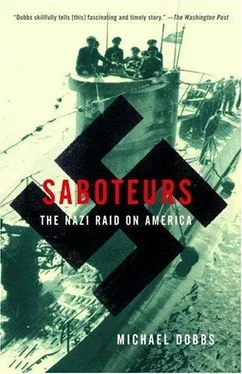In addition to his Abwehr office, Kappe also had a conspiratorial hideaway known as “the bunker” in the commercial district of the city at Rankestrasse 6, a tree-lined street leading down from the Kaiser Wilhelm Church on the Kurfürstendamm. Here he held court in a fourth-floor safe house behind a smoked-glass door with a sign that read Schriftleiting Der Kaukasus, the Editors of The Caucasus. 19The name over the bell was Röhrich. Both Herr Röhrich and the Kaukasus magazine were figments of Kappe’s fertile imagination.
Visitors to the bunker were ushered into a reception room decorated with Baroque furniture. A concealed microphone and spy hole permitted Kappe to keep an eye on whatever was going on in the reception room from his secretary’s office next door. The rest of the apartment consisted of a bedroom, dining room, kitchen, and bathroom, each opening into an L-SHAPED corridor.
Over the previous five months, Kappe had invited several dozen German-American returnees to the bunker for screening as potential saboteurs. Some, like Dasch, had approached the Abwehr by themselves, looking for a job with foreign intelligence. Most had been the targets of an aggressive recruiting campaign by Kappe. The former Bund rabble-rouser had spent hours poring over the files of the Ausland Institut, the Nazi Party office that coordinated relations with foreign countries. By sifting through questionnaires submitted by returnees, Kappe was able to identify candidates for a future sabotage mission. He also addressed reunions of former Bund members around Germany, during which he insinuated that there were ways to “help the Fatherland” back in America. This was how he came across Heinck and Quirin, two returnees who had found work with Volkswagen.
Kappe had ordered Dasch and Kerling, the two group leaders, to report to Abwehr headquarters on May 11, the day before the rest of the men, for further instructions in secret writing. They spent that Monday morning in the laboratory, dabbling with handkerchiefs and matches impregnated with an invisible ink. Abwehr officials also gave them the address of a mail drop in Lisbon, through which they could communicate with Berlin with some delay. As a neutral country, Portugal still had mail service with both the United States and Germany.
They had lunch at Kappe’s favorite restaurant on the Nollendorfplatz, a fifteen-minute stroll from Abwehr headquarters on the other side of the canal. As they walked to the restaurant, Kappe raised the question of finances. 20He proposed giving each group leader $50,000 “for operational purposes,” and $5,000 for each agent. In addition, every man on the mission would carry a specially designed money belt containing $4,000, plus $450 in ready cash for immediate use. In all, the two groups would take over $180,000 with them to the United States, the equivalent of two million dollars today. Dasch suggested sewing his cash into the lining of an old Gladstone bag that he had picked up in America.
After lunch, the discussion turned to the best landing places on America’s two-thousand-mile eastern coastline. Dasch knew Long Island well, particularly the Hamptons. 21He had worked as a waiter at various inns in East Hampton and Southampton, and thought that the broad expanse of sand on the southeastern tip of Long Island would be the perfect place to bring in a dinghy. For his group, Kerling proposed the beaches of northern Florida around Jacksonville. He was familiar with this stretch of coastline as a result of his adventures on the Lekala two years earlier. After intercepting the boat off Atlantic City and impounding it for three weeks, the U.S. authorities had permitted Kerling and his friends to sail it down to Florida so they could sell it. But there was a stringent condition designed to prevent the Bundists from making a dash across the Atlantic: they were obliged to report to every Coast Guard station between New York and Miami.
When the rest of the men reported to the bunker the following day, Kappe announced that submarines were not immediately available for their voyage across the Atlantic. 22Instead, they would take part in a field trip intended to familiarize them with the targets of their sabotage mission.
First stop on the tour was the canal system around Berlin. Their guide was Dasch’s relative Barth, a mousy, nearsighted man who had worked for six years on the Long Island Rail Road cleaning coaches and repairing railway cars. 23While in America, Barth had also served as the Bund’s logistics expert, organizing special trains to transport large groups of American Nazis to parades and training camps around Long Island. This was how Barth had first come into contact with Kappe.
Rain was pouring down as the saboteurs clambered aboard a boat, making Berlin seem even grayer and bleaker than usual. 24The first lock they inspected had wooden doors on large metal hinges, which opened to permit water levels to rise and fall. The best way to destroy such a lock, Barth instructed, was to apply a couple of sticks of dynamite to the hinge, the weakest point in the lock. Once one or two locks had been destroyed, the force of tumbling water would usually be sufficient to rip out all the locks lower down in the system.
Next, they inspected a more modern type of lock that rose up and down with a pulley-and-cable mechanism. Barth recommended putting this kind of lock out of action by disabling the machinery that pulled the doors up and down. Another method of putting a canal out of action was to sink a concrete-laden barge in the middle of the stream.
The next day, Barth took the saboteurs to see a railroad repair shop. They were introduced as counterintelligence agents, studying how to combat sabotage by Russian partisans. 25The chief engineer seemed satisfied with this explanation. He took them through the shop, pointing out the kind of targets that might interest a saboteur and describing the workings of a steam engine.
After lunch, they walked to a nearby railroad yard. At Quenz Lake, Barth had already given the men a detailed explanation of American rolling stock, identifying the weak points on different types of equipment. Climbing on top of a locomotive, he pointed out a simple way of disabling the engine by putting sand in the cylinders or in the oil boxes, a method favored by Russian saboteurs.
A more sophisticated way of achieving the same result, Barth explained back in the Kaukasus office, was to use the exploding coal designed by Abwehr specialists, which was armed by a detonating cap. Several lumps of such coal thrown into the tender of a locomotive would eventually make their way into the furnace, causing the train to “go high up in the air.” 26
THE HIGHLIGHT of the inspection tour was a two-day trip to the aluminum and magnesium plants of the IG Farben group. In addition to the nine saboteurs, half a dozen officials went along for the trip, including Kappe, a representative of the Army High Command, a man from Farben headquarters, and the two Herr Doktors from the sabotage school. They left Berlin by train at six o’clock on Thursday morning, arriving in Bitterfeld three hours later. From the rail station, a bus took them to the aluminum plant, the biggest in Germany.
The group listened to a lecture on the aluminum manufacturing process, with frequent reminders on the importance of destroying the power supply. Then they inspected the plant, whose layout was very similar to facilities run by the Aluminum Company of America, the company that dominated aluminum production throughout the United States. Some of the Farben engineers were able to talk very knowledgeably about the challenges facing the saboteurs as they had been to the Alcoa factories before the war.
First stop on the tour were the electric baths where molten ores were turned into aluminum. They moved on to the main powerhouse to inspect the transformers that reduced the incoming power voltage from a hundred thousand volts to the much lower level necessary to feed the electrolysis machines. Farben officials showed them how to destroy the transformers by placing explosives next to the air-cooling system, which would cause the oil to drain out of the cooler. An alternative method was to shoot a high-velocity bullet between the metal ribs of the cooling system.
Читать дальше












